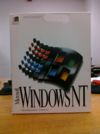Difference between revisions of "Windows NT"
(→Windows NT 3.1) |
(→Windows NT 3.5) |
||
| Line 33: | Line 33: | ||
== Windows NT 3.5 == | == Windows NT 3.5 == | ||
| − | Codenamed Daytona, this relase added several optimizations, and notibly added support for the PCI bus, and Dec Alpha CPU's. It was released on September 21st, 1994. The build number was 807. | + | Codenamed Daytona, this relase added several optimizations, and notibly added support for the PCI bus, and the Dec Alpha CPU's shipped on the CD. It was released on September 21st, 1994. The build number was 807. |
| + | |||
| + | The Windows NT 3.5 SDK included the Dec Alpha CLI tools. | ||
== Windows NT 3.51 == | == Windows NT 3.51 == | ||
Revision as of 17:43, 17 August 2009
Contents
Background
Windows NT started life as NT OS/2. Oringally it was a future thinking version of OS/2 that would be portable, and was targeted for the comming RISC cpu's. The goal was to design a microkernel OS that could run 32 bit POSIX binaries, 16 bit OS/2 1.x binaries, 16 bit MS-DOS & Windows binaries with an improved 32bit OS/2 API & Windowing system. Microsoft hired Dave Cutler away from Digitial to help with the implementation of the OS, back in 1988.
It is important to remember that the NT project started in 1988, and where Microsft was product wise. Released products in 1988 were:
Learning DOS 2.0, Microsoft Stat Pack on CD-ROM, MS-DOS 4.01, Small Business Consultant 1.0 on CD-ROM, SQL Server Network Developers Kit 1.0, Excel for OS/2, Word 5.0 for PC, Quick Basic 4.5, Excel for Windows 2.1, OS/2 Software Development kit 1.2, Microsoft Programmer’s Library on CD-ROM, Quick Basic 1.0 for Mac, MS-DOS CD-ROM Extensions 2.0, COBOL Optimizing Compiler 3.0, Flight Simulator 3.0 for PC, PowerPoint 2.01 for Mac, Learning DOS 2.0, Stat Pack 1.0
NT OS/2 was originally targeted to the Intel i860 cpu. This was done to keep Windows NT portable, and not fall into i386'isims into the original base source. This is where the NT in NT comes from, processor they used was called the "N-Ten" from the i860 XR processor. It was quickly apparent though that the i860 was NOT going to be a good workstation CPU, and the effort was quickly moved to the MIPS CPU, and Microsoft built their own motherboard design the JAZZ.
However after the release of Windows 3.0, Microsoft started to shift the primary API of NT OS/2 to the Windows API. The 16 bit emulation for OS/2 applications remained, however the Graphical Interface for OS/2 programs became a seperate product. This started the rift that would end the Microsoft IBM collaboration.
With NT OS/2 renamed to Windows NT, the first public beta was released in July of 1992, at the Professional Developers Conference in San Francisco. Another beta was released November 11th, 1992.
Windows NT 3.1
This was the first public release of Windows NT, and the Win32 API. NT 3.1 was released on July 27th 1993. The build number is 528. NT 3.1 supported the i386 cpu, and the MIPS R4000. Inside some boxes was a coupon for the Dec Alpha version. NT 3.1 was apparently already ported to the Dec Alpha, however none of the ARC capapable machines were 'production grade' so they couldn't certify for certain that it'd work. Later copies of NT 3.1 have an ALPHA directory.
Windows NT 3.1 does NOT support PCI busses. It is limited to ISA/EISA only. However some PCI periphials can be driven by ISA drivers for things that map to ISA space... Like Video cards.
Windows NT 3.1 had the following subsystems:
- Win32
- Win16
- NTVDM
- OS2
- POSIX
On the i386 the maximum memory supported is 64MB (which was common limitation of ISA machines back then).
Windows NT 3.5
Codenamed Daytona, this relase added several optimizations, and notibly added support for the PCI bus, and the Dec Alpha CPU's shipped on the CD. It was released on September 21st, 1994. The build number was 807.
The Windows NT 3.5 SDK included the Dec Alpha CLI tools.
Windows NT 3.51
This release added the PowerPC cpu support that was done by IBM. I've heard that NT 3.51 was actually 'done' 9 months prior to it's release but Microsoft had to wait for IBM to finish the PowerPC port. Meanwhile Microsoft did a LOT of bug fixing making this a very popular release for corporations. While it retained the look & feel of Windows 3.1 the newshell beta was available towards the end of the products lifespan, giving NT 3.51 a Windows 95 feel. It was released on May 30th, 1995 and it's build number was 1057.
Windows NT 4.0
Windows NT 4.0 was released on August 24th, 1996. It's build number is 1381. Initially it supported the Alpha, i386, Mips and PowerPC cpu's. However the MIPS cpu was dropped right after service pack 1. The PowerPC cpu was dropped right before service pack 3. The Dec Alpha would see mainstream support right thru the Windows NT 4.0 product life cycle.
Windows NT 4.0 Terminal Server
This was the first Microsoft multiuser version of Windows, with technology given back from Citrix. I recall Microsoft strongarmed the Citrix people into this 'deal'... Anyways it had Service pack 3 built into it, and thus only supported the Alpha & i386 cpus. It was released around June of 1998

